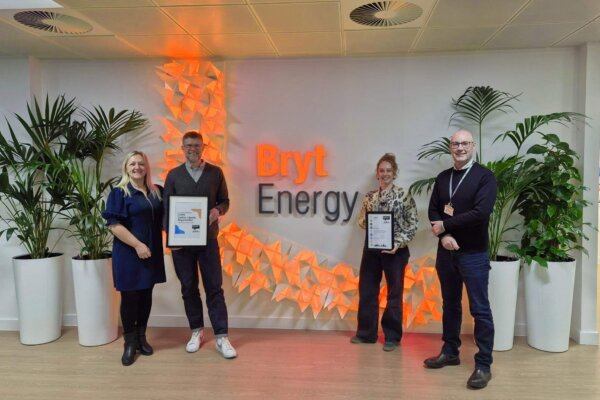In our first edition of Bryt Insight this year, we look at how the UK is continuing its journey towards net zero. From expanding and improving the UK Government’s Emissions Trading Scheme, to new standards aimed at decarbonising buildings, here’s what you need to know this month:
UK Government launches new consultation on Future Homes and Buildings Standards
UK Government to extend its UK Emissions Trading Scheme to 2050
Government report reveals UK manufacturing sector faces energy efficiency challenges
Spotlight on Renewables
News in Brief
UK Government launches new consultation on Future Homes and Buildings Standards
The UK Government’s Department for Levelling Up, Housing, and Communities has launched a new consultation setting out plans for achieving the Future Homes and Buildings Standards, which aim to improve the energy efficiency of new homes and non-domestic buildings1. Its proposals include a mandate to install low-carbon heat pumps and use highly insulating fabrics in the construction of all new buildings, ensuring they are ‘net zero ready’ by 2025.
The UK’s buildings, from offices to homes, contribute to around 30% of the country’s greenhouse gas (GHG) emissions – making them the second largest carbon emitter behind transport2. By improving the energy efficiency of buildings, the Government hopes to reduce this overall energy usage, supporting the UK’s ongoing net zero transition. Higher building standards should also help lower heating costs, as well as creating more comfortable spaces across the UK that are easier to keep warm or cool. The consultation proposes a transitional period, granting the industry 6-12 months to adapt before new building standards take effect in 2025.
The Future Homes and Buildings Standards is also set to offer economic benefits for UK supply chains, including investments in UK heat pump manufacturing and new heating engineer jobs, potentially making the UK Europe’s largest market for heat pumps by the end of this decade.
Reforming Energy Performance Certificates
Alongside this, a recent report by Energy Systems Catapult – an independent research and technology organisation – has called for reform of Energy Performance Certificates (EPCs), which are currently used to rate the energy efficiency of buildings3.
The report suggests that current rating metrics aren’t aligned with aims to accelerate the decarbonisation of buildings. The EPC rating currently focuses on energy usage and running costs, favouring properties using energy efficient but carbon-intensive options – such as gas boilers – which will soon need replacing as the UK transitions towards low-carbon heating. On the other hand, similar properties with lower carbon alternatives – such as air source heat pumps – can often have a worse EPC rating. Despite this, the Government requires all non-domestic buildings to achieve EPC B rating by 2030, meaning a potential misalignment of targets.
The report recommends a shift to new metrics, including a ‘climate impact metric’ that offers a clear view of energy-related carbon emissions. The report also suggests complementing the EPC with a Smart Building Rating (SBR), which rates a building’s capacity to offer flexibility to the grid, helping to support the transition to a net zero electricity system.
To read Energy Systems Catapult’s report on EPCs, click here.
The UK Government’s consultation on its Future Homes and Buildings Standard is open to all stakeholders, and if you’d like to contribute, you can do so here until March 6th, 2024.
UK Government to extend its UK Emissions Trading Scheme to 2050
The Department for Energy Security and Net Zero (DESNZ) has confirmed that the UK Emissions Trading Scheme (ETS) will be extended to 2050 and has released a set of proposals intending to optimise the scheme and support energy-intensive businesses to decarbonise4.
The Government’s ETS scheme acts as a cap-and-trade scheme that allocates carbon allowances to businesses, and caps the total level of greenhouse gas emissions a business can emit. This creates a market for businesses to trade and sell excess carbon allowances, which incentivises industries to limit their emissions and invest in decarbonisation initiatives. The Government has launched two consultations on proposed improvements to the scheme, which aim to promote market stability and ensure it is fit for purpose in supporting businesses in the net zero transition.
If you’d like to have your say on the Government’s ETS scheme, you can access their consultation here until March 11th, 2024.
For more updates about the Government’s ETS scheme, you can read our previous edition of Bryt Insight.
Government report reveals UK manufacturing sector faces energy efficiency challenges
A recently published report, first commissioned in 2021 by the UK Government, has suggested that costs and technical issues are key barriers hindering progress in energy efficiency across the UK’s manufacturing sector5.
Drawing insights from surveys conducted with over 1,000 UK firms, the report reveals that only 36% of manufacturing businesses monitor their energy usage, while just 11% of firms consistently monitor both their energy usage and energy efficiency. However, the report also found that 99% of large manufacturers monitor their energy usage, compared to 37% of micro manufacturers.
Financial constraints were indicated as the main barrier to enhancing site energy efficiency, with 51% of businesses surveyed citing costs hindering the implementation of necessary measures.
The Government also published a report exploring how international policies aimed at improving industrial energy efficiency should inform UK policy. It suggested that prioritising the implementation of energy efficiency measures, rather than energy consumption targets, is a more effective way to aid broader decarbonisation objectives6.
By understanding their operational data and monitoring their usage, businesses can identify opportunities for efficiencies, helping them reduce their consumption and costs whilst supporting a net zero future.
To learn more, you can read the Government’s report on energy efficiency in the UK manufacturing sector, as well as its report detailing insights from international industrial energy policy.
Spotlight on Renewables
- Statkraft, our parent company, has acquired the Loch Ness pumped storage hydro project, which has a renewable capacity of 450MW7. When built, the hydro project will function like a battery, capturing and storing surplus renewable energy until it is needed during times of high demand. This will help to ensure stability and supply security in the UK, supporting the electricity system as it transitions away from fossil fuels. You can read Statkraft’s press release to learn more.
- In 2023, electricity from fossil fuels fell to its lowest level since 1957, contributing just 35% of Britain’s total electricity production8. While only 104TWh was generated from fossil fuels, renewable sources generated 135TWh – increasing almost six-fold from the 23TWh generated in 2008 – indicating continuous progress towards decarbonising the UK’s electricity system. If you’re interested in learning more, visit Carbon Brief’s website.
- In other encouraging news for UK renewables, wind generated a new high of 21.8GW of electricity on 21st December, providing 56% of the UK’s fuel generation mix and breaking the previous record set in January 20239.
News in Brief
- A new forecast by the IMF has suggested that the economic benefits of the net zero transition would outweigh the costs of doing nothing10. Accelerating policies to mitigate climate change, and therefore avoiding the costs of extreme weather impacts, has been found to potentially increase gross domestic product (GDP) by 7%. To learn more, visit IMF’s blog.
- The UK’s energy network operators have unveiled proposals to speed up the connection of renewable generation and storage projects to the grid, committing to deliver an additional 139GW of capacity in 202411. This is a significant target as, according to the Energy Networks Association (ENA), the UK must install a total of 225GW of new capacity to decarbonise its electricity grid by 203512. For more information, we dive deeper into ways to reduce grid connection delays in December’s edition of Bryt Insight.
- The UK Government has unveiled plans for a new Carbon Border Adjustment Mechanism (CBAM), which will place a carbon price on emissions-intensive goods imported to the UK. This aims to support the domestic competitiveness of UK industry and incentivise global decarbonisation efforts, particularly in countries that are currently lacking carbon pricing standards13. By 2027, imported products from sectors such as iron, steel, aluminium and cement will carry a comparable carbon price to domestically produced goods, supporting UK business while addressing carbon emissions in international trade. To learn more, visit the UK Government’s website.
- A recent report has revealed a substantial increase in the UK’s energy storage project pipeline – from 50.3GW in 2022 to 84.8GW in 202314. Energy storage solutions play a vital role in the UK’s net zero energy transition, improving resilience and contributing to building a flexible grid system powered by renewables. We look at energy storage solutions, alongside other low-carbon technologies needed for a net zero future, in Part 3 of our e-guide series – ‘Navigating the Net Zero Energy Transition’ – which you can access here.
- National Grid has begun to power the UK with electricity from its Viking Link, the world’s longest land and subsea electricity interconnector spanning 475 miles between the UK and Denmark15. The link will have 1.4GW of capacity by 2024, helping to hit the UK’s target for 18GW of interconnection capacity by 2030. Viking Link is set to offer significant benefits to UK consumers, including increased energy security and £500 million of cumulative savings over the next decade. Interconnectors like this will be key in the net zero energy transition, helping to balance supply and demand by enabling the efficient exchange of excess renewable energy among neighbouring countries. To learn more, visit National Grid’s website.
TALK TO OUR TEAM
If you have any questions on how any of the updates might affect your business, our team of experts is on hand to answer them. You can get in touch with us on 01217267575 or at heretohelp@brytenergy.co.uk.
Sources
- https://www.gov.uk/government/consultations/the-future-homes-and-buildings-standards-2023-consultation
- https://assets.publishing.service.gov.uk/media/657731b00467eb001355f50f/Future_Buildings_Standard_consultation_stage_impact_assessment.pdf
- https://es.catapult.org.uk/news/epcs-undermining-decarbonisation-efforts/
- https://www.gov.uk/government/publications/uk-emissions-trading-scheme-long-term-pathway/the-long-term-pathway-for-the-uk-emissions-trading-scheme
- https://www.gov.uk/government/publications/energy-efficiency-in-the-uk-manufacturing-sector
- https://www.gov.uk/government/publications/international-industrial-energy-efficiency-policy-insights-for-the-uk
- https://www.statkraft.co.uk/newsroom/2023/statkraft-to-acquire-major-loch-ness-pumped-storage-hydro-project/
- https://www.carbonbrief.org/analysis-uk-electricity-from-fossil-fuels-drops-to-lowest-level-since-1957/
- https://www.nationalgrideso.com/electricity-explained/electricity-and-me/great-britains-monthly-electricity-stats
- https://www.imf.org/en/Blogs/Articles/2023/12/05/benefits-of-accelerating-the-climate-transition-outweigh-the-costs
- https://theenergyst.com/operators-pledge-139-gw-next-year-towards-speeded-up-grid-decarbonisation/
- https://www.energynetworks.org/newsroom/rising-to-britains-net-zero-challenge-report
- https://www.gov.uk/government/news/new-uk-levy-to-level-carbon-pricing.
- https://www.renewableuk.com/news/660775/Pipeline-of-UK-energy-storage-projects-grows-by-two-thirds-over-last-12-months.htm
- https://www.nationalgrid.com/national-grid-announces-commercial-operations-viking-link-worlds-longest-land-and-subsea


